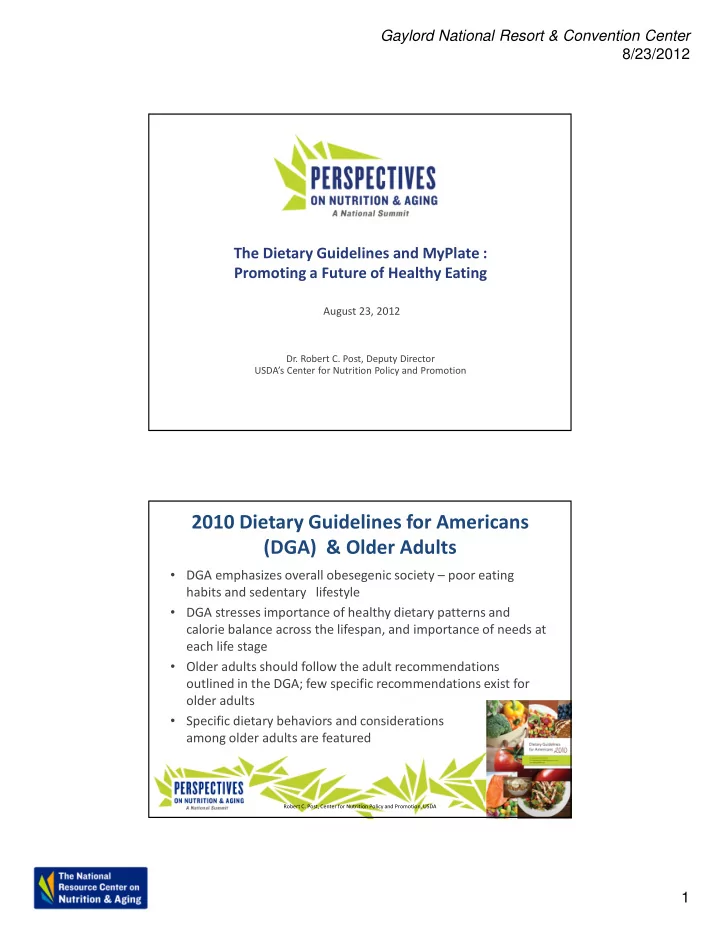

Gaylord National Resort & Convention Center 8/23/2012 The Dietary Guidelines and MyPlate : Promoting a Future of Healthy Eating August 23, 2012 Dr. Robert C. Post, Deputy Director USDA’s Center for Nutrition Policy and Promotion 2010 Dietary Guidelines for Americans (DGA) & Older Adults • DGA emphasizes overall obesegenic society – poor eating habits and sedentary lifestyle • DGA stresses importance of healthy dietary patterns and calorie balance across the lifespan, and importance of needs at each life stage • Older adults should follow the adult recommendations outlined in the DGA; few specific recommendations exist for older adults • Specific dietary behaviors and considerations among older adults are featured Robert C. Post, Center for Nutrition Policy and Promotion, USDA 1
Gaylord National Resort & Convention Center 8/23/2012 NutritionEvidenceLibrary.gov (NEL.gov) Factors Associated With Dietary Quality Among Older Adults • Socioeconomic status, education, race/ethnicity, age, locality, and living arrangements are associated with overall nutritional status. • Health status and the related difficulties or disabilities can influence the purchase, preparation, and consumption of food. Robert C. Post, Center for Nutrition Policy and Promotion, USDA 2
Gaylord National Resort & Convention Center 8/23/2012 2010 Dietary Guidelines & Older Adults • Older adults are encouraged to achieve and maintain a healthy body weight. • Older adults over the age of 65 who are overweight are encouraged to avoid weight gain. • Intentional weight loss can be beneficial. Robert C. Post, Center for Nutrition Policy and Promotion, USDA Special Considerations for Older Adults – Weight Loss • Moderate evidence indicates a reduced risk of mortality with intentional weigh loss. • Also suggests reduced development of type 2 diabetes and improved cardiovascular risk factors. • Weight loss is appropriate advice for older adults who are overweight and obese. • Weight gain should be avoided. Robert C. Post, Center for Nutrition Policy and Promotion, USDA 3
Gaylord National Resort & Convention Center 8/23/2012 Special Considerations for Older Adults – Food Safety • A critical part of healthy eating is keeping foods safe. • Every year, foodborne illness affects more than 76 million individuals in the United States. • Contributes to 325,000 hospitalizations and 5,000 deaths. Robert C. Post, Center for Nutrition Policy and Promotion, USDA Special Consideration for Older Adults - Sodium Older adults should reduce their sodium intake to 1,500 mg per day. Robert C. Post, Center for Nutrition Policy and Promotion, USDA 4
Gaylord National Resort & Convention Center 8/23/2012 Special Consideration for Older Adults - Water • Individual water intake needs vary widely, based in part on level of physical activity and exposure to heat stress. • Warmer outdoor temperatures have the potential to result in an increased risk of dehydration, especially in older adults. Robert C. Post, Center for Nutrition Policy and Promotion, USDA Recommendation for Older Adults – Vitamin B 12 • Consume foods fortified with vitamin B 12 , such as fortified cereals, or dietary supplements. • A substantial proportion of individuals ages 50 years and older may have reduced ability to absorb naturally occurring vitamin B 12. Robert C. Post, Center for Nutrition Policy and Promotion, USDA 5
Gaylord National Resort & Convention Center 8/23/2012 Special Consideration for Older Adults – Physical Activity • Follow the physical activity adult guidelines. • Do exercises that maintain or improve balance. • Determine level of effort for physical activity relative to the level of fitness. • Understand whether and how specific conditions affect individual ability to do regular physical activity safely. Robert C. Post, Center for Nutrition Policy and Promotion, USDA How Well are Older Adults Doing? 6
Gaylord National Resort & Convention Center 8/23/2012 MyPlate: Supported by An Innovative Communications Initiative Coordinated, evidence-based approach to influence consumers’ behaviors where they purchase, prepare, and consume food Coordinated Messaging- “How-Tos” Resources National and Community Partnerships On-Line E-Tools (SuperTracker) Social and Consumer Engagement Robert C. Post, Center for Nutrition Policy and Promotion, USDA 7
Gaylord National Resort & Convention Center 8/23/2012 Unified and Coordinated Messages: Based on Key Dietary Guidelines Behaviors Dates Theme Selected Key Message Make half your plate fruits and vegetables. Sept. – Dec. 2011 Foods to Increase Enjoy your food, but eat less. Jan. – Apr. 2012 Balancing Calories May – Aug. 2012 Foods to Reduce Drink water instead of sugary drinks. Make at least half your grains whole grains. Sept. – Dec. 2012 Foods to Increase Avoid oversized portions. Jan. – Apr. 2013 Balancing Calories May – Aug. 2013 Foods to Reduce Compare sodium in foods... Switch to fat-free or low-fat (1%) milk. Sept. – Dec. 2013 Foods to Increase Robert C. Post, Center for Nutrition Policy and Promotion, USDA Some of Our National Strategic Partners 8
Gaylord National Resort & Convention Center 8/23/2012 Evaluating Impact Over Time MyPlate is #2 Top Food News Story in 2011 90% of nutrition professionals are using MyPlate in practice 34 million page views at ChooseMyPlate.gov: Jan – Mar 950,000 registered users of SuperTracker 2.83 billion media impressions for message outreach 65 million consumers reached for first message “Make Half Your Plate Fruits and Vegetables” Robert C. Post, Center for Nutrition Policy and Promotion, USDA Evaluating Impact Over Time Baseline Consumer Consumer intention Implementation Markers (awareness, Survey data on food and self-report data understanding, patterns Mechanisms on behaviors receptiveness, etc.) The influence of MyPlate communications should be measured over time; currently identifying baseline consumer markers such as awareness and understanding. Robert C. Post, Center for Nutrition Policy and Promotion, USDA 9
Recommend
More recommend